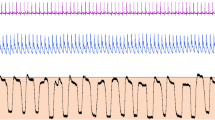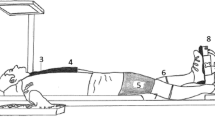Summary
Blood pressure and heart rate changes during sustained isometric exercise were studied in 11 healthy male volunteers. The responses were measured during voluntary and involuntary contractions of the biceps brachii at 30% of maximal voluntary contraction (MVC), and the triceps surae at 30% and 50% MVC. Involuntary contractions were evoked by percutaneous electrical stimulation of the muscle.
Measurements of the time to peak tension of maximal twitch showed the biceps brachii (67.0±7.9 ms) muscle to be rapidly contracting, and the triceps surae (118.0±10.5 ms) to be slow contracting. The systolic and diastolic blood pressures increased linearly throughout the contractions, and systolic blood pressure increased more rapidly than diastolic. There was no significant difference in response to stimulated or voluntary contractions, nor was there any significant difference between the responses to contractions of the calf or arm muscles at the same relative tension.
In contrast the heart rate rose to a higher level (P<0.01) in the biceps brachii than the triceps surae at given % MVC, and during voluntary compared with the electrically evoked contractions in the two muscle groups.
It was concluded that the arterial blood pressure response to isometric contractions, unlike heart rate, is primarily due to a reflex arising within the active muscles (cf. Hultman and Sjöholm 1982) which is associated with relative tension but independent of contraction time and muscle mass.
Similar content being viewed by others
References
Bolstad G, Ersland A (1978) Energy metabolism in different human skeletal muscles during voluntary isometric contractions. Eur J Appl Physiol 38: 171–179
Clement DL, Pannier JL (1980) Cardiac output distribution during induced static muscular contractions in the dog. Eur J Appl Physiol 45: 199–207
Coote JH, Hilton SH, Perez-Gonzalez JF (1971) The reflex nature of the pressor response to muscular exercise. J Physiol 215: 79–804
Davies CTM, White MJ (1983) Contractile properties of elderly human triceps surae. Gerontology 29: 19–25
Davies CTM, Mecrow IK, White MJ (1982) Contractile properties of the human triceps surae with some observations on the effects of temperature and exercise. Eur J Appl Physiol 49: 255–269
Donald KW, Lind AR, McNicol GW, Humphreys PW, Taylor SH, Staunton HP (1967) Cardiovascular responses to sustained (static) contractions. Circ Res [Suppl I] 20/21: 15–32
Freyschuss U (1970) Cardiovascular adjustment to somatomotor activation. Acta Physiol Scand [Suppl] 342: 1–63
Goldberg LI, White DJ, Pandolf KB (1982) Cardiovascular and perceptual responses to isometric exercise. Arch Phys Med Rehabil 63: 211–216
Goodwin GM, McCloskey DI, Mitchell JH (1972) Responses to changes in central command during isometric exercise at constant muscle tension. J Physiol 226: 173–190
Hultman E, Sjöholm H (1982) Blood pressure and heart rate response to voluntary and non-voluntary static exercise in man. Acta Physiol Scand 115: 499–501
Johnson MA, Polgar J, Weightman D, Appleton D (1973) Data on the distribution of fibre types in thirty-six human muscles — an autopsy study. J Neurol Sci 18: 111–129
Jones PRM, Pearson J (1969) Anthropometric determination of leg fat and muscle plus bone volumes in young male and female adults. J Physiol 204: 63–66P
Lind AR, McNicol GW (1967) Circulatory responses to sustained handgrip contractions performed during other exercise, both rhythmic and static. J Physiol 192: 595–607
Lind AR, Taylor SR, Humphreys PW, Kennelly BM, Donald KW (1964) The circulatory effects of sustained voluntary muscle contraction. Clin Sci 27: 229–244
Lind AR, McNicol GW, Bruce RA, Macdonald HR, Donald KW (1968) The cardiovascular responses to sustained contractions of a patient with unilateral syringomyelia. Clin Sci 35: 45–53
Marsden CD, Meadows JC (1970) Effect of adrenalin on the contraction of human muscle and its isometric twitches. J Physiol 207: 461–499
McCloskey DI, Mitchell JH (1972) Reflex cardiovascular and respiratory responses originating in exercising muscle. J Physiol 224: 173–186
McCloskey DI, Streatfield KA (1975) Muscular reflex stimuli to the cardiovascular system during isometric contractions of muscle groups of different mass. J Physiol 250: 431–441
McDonagh MJN, Hayward CM, Davies CTM (1983) Isometric training in human elbow flexor muscles: the effects on voluntary and electrically evoked forces. J Bone Joint Surg 65B: 355–358
Mitchell JH, Schibye B, Panye FC, Saltin B (1981) Response of arterial blood pressure to static exercise in relation to muscle mass, force development and electromyographic activity. Circ Res 48: 70–75
Petrofsky JS, Lind AR (1980) The blood pressure response during isometric exercise in fast and slow twitch skeletal muscle in the cat. Eur J Appl Physiol 44: 223–230
Author information
Authors and Affiliations
Rights and permissions
About this article
Cite this article
Davies, C.T.M., Starkie, D.W. The pressor response to voluntary and electrically evoked isometric contractions in man. Europ. J. Appl. Physiol. 53, 359–363 (1985). https://doi.org/10.1007/BF00422854
Accepted:
Issue Date:
DOI: https://doi.org/10.1007/BF00422854




